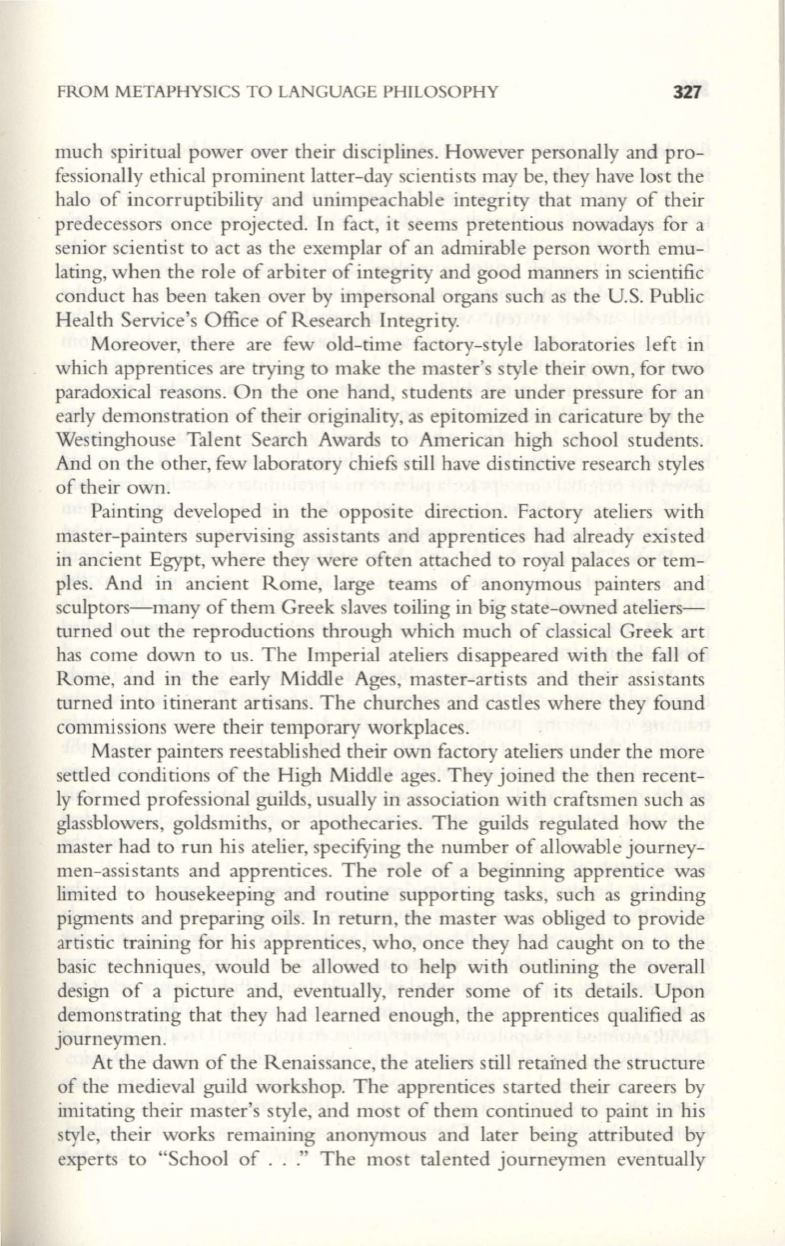
FROM METAPHYSICS TO LANGUAGE PHILOSOPHY
327
much spiritual power over their disciplines. However personally and pro–
fessionally ethical prominent latter-day scientists may be, they have lost the
halo of incorruptibility and unimpeachable integrity that many of their
predecessors once projected. In fact, it seems pretentious nowadays for a
senior scientist to act as the exemplar of an admirable person worth emu–
lating, when the role of arbiter of integrity and good manners in scientific
conduct has been taken over by impersonal organs such as the U.S. Public
Health Service's Office of Research Integrity.
Moreover, there are few old-time factory-style laboratories left in
which apprentices are trying to make the master's style their own, for two
paradoxical reasons. On the one hand, students are under pressure for an
early demonstration of their originality, as epitomized in caricature by the
Westinghouse Talent Search Awards to American high school students.
And on the other, few laboratory chiefs still have distinctive research styles
of their own.
Painting developed in the opposite direction. Factory ateliers with
master-painters supervising assistants and apprentices had already existed
in ancient Egypt, where they were often attached to royal palaces or tem–
ples. And in ancient Rome, large teams of anonymous painters and
sculptors-many of them Greek slaves toiling in big state-owned ateliers–
turned out the reproductions through which much of classical Greek art
has come down to us. The Imperial ateliers disappeared with the fall of
Rome, and in the early Middle Ages, master-artists and their assistants
turned into itinerant artisans. The churches and castles where they found
commissions were their temporary workplaces.
Master painters reestablished their own factory ateliers under the more
settled conditions of the High Middle ages. They joined the then recent–
ly formed professional guilds, usually in association with craftsmen such as
glassblowers, goldsmiths, or apothecaries. The guilds regulated how the
master had to run his atelier, specifying the number of allowable journey–
men-assistants and apprentices. The role of a beginning apprentice was
limi
ted to housekeeping and routine supporting tasks, such as grinding
pigments and preparing oils. In return, the master was obliged to provide
artistic training for his apprentices, who, once they had caught on to the
basic techniques, would be allowed to help with outlining the overall
design of a picture and, eventually, render some of its details. Upon
demonstrating that they had learned enough, the apprentices qualified as
Journeymen.
At the dawn of the Renaissance, the ateliers still retained the structure
of the medieval guild workshop. The apprentices started their careers by
imitating their master's style, and most of them continued to paint in his
style, their works remaining anonymous and later being attributed by
experts to "School of ..." The most talented journeymen eventually


